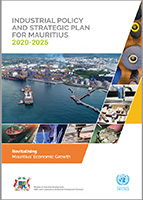
This Industrial Policy and Strategic Plan contains a wide range of recommendations to support the continued growth and development of Mauritius' industrial capacity and capabilities. These recommendations are intended to support the realization of Mauritius' bold national 2030 vision, which is the achievement of high-income status, supported by a highly productive manufacturing sector contributing a quarter of the country's GDP. Stemming from a comprehensive stakeholder consultation process, and independent analysis of Mauritian manufacturing capabilities, the working vision and associated set of objectives that have been defined for the Mauritian manufacturing sector through to 2030 are presented in Table 1.
Table 1: Summary of industrial policy vision and associated objectives to 2030
| Vision | Objectives to 2030 |
|
A globally competitive and sustainable industrial sector that contributes to higher economic growth for Mauritius through continuous innovation, technology upgrading, productivity gains and high skilled employment. |
|
Achieving the vision and its associated objectives will require a bold institutional approach to Mauritius' industrial policy development and deployment. The primary recommendation that takes precedence over the balance of recommendations made, is, therefore, the establishment of an Industrial Policy Executive Oversight Committee that reports to the Ministry of Industrial Development, SMEs and Cooperatives, and that is responsible for monitoring and evaluating the realisation of the strategy over its lifespan.
The 22 recommendations made group recommendations as either coordination, infrastructure or incentive based. In certain instances, a specific recommendation is both coordination and infrastructure based. This occurs where a recommendation requires an investigation before appropriate infrastructure can be established. Infrastructure and coordination recommendations do not have indicative budgets, with the expectation that they are covered under an existing budget that may need to be amended or revised to accommodate the proposed interventions.
The objectives articulated in Table 1 should be the guiding framework when analysing the impact of the various recommendations. Where the recommended infrastructure, coordination interventions, and incentives are clearly delivering on the growth rates required and represent demonstrated value to both the government and private sector they should potentially be expanded; and where they are falling short, it is essential that they are reviewed, and either remedied or replaced. As comprehensively documented in this report, Mauritius is at a structural crossroads. If manufacturing and the broader industrial sector are central to the national project of sustaining high income status by 2030, an innovative, well resourced, and carefully monitored industrial policy is required.





